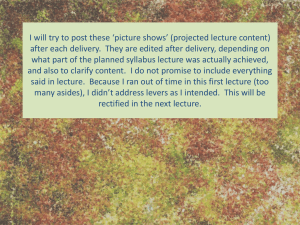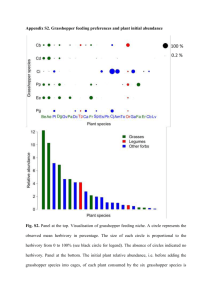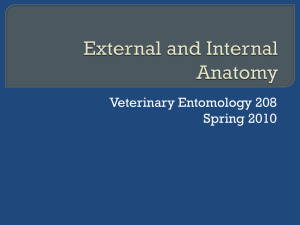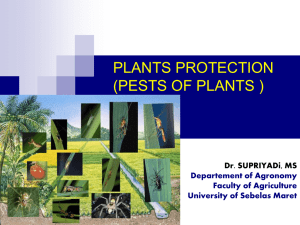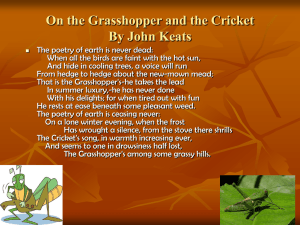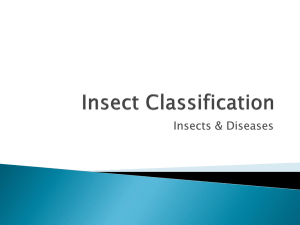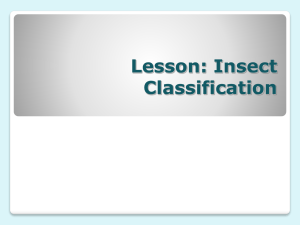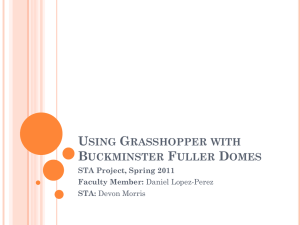BIO 325 Lab 1
advertisement
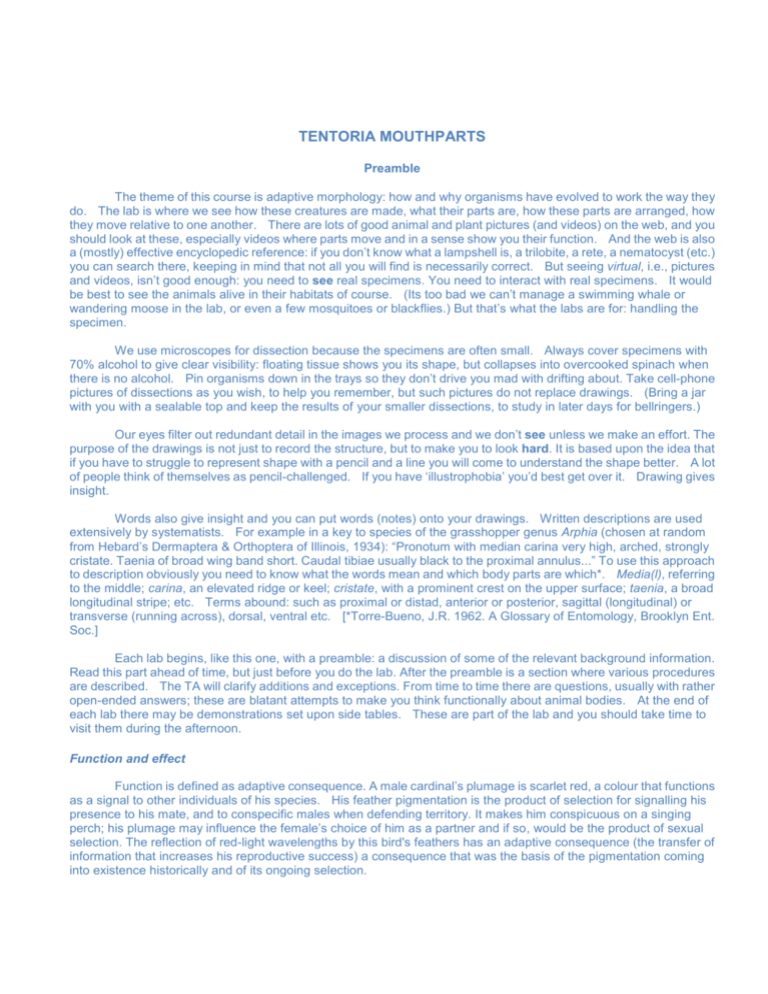
TENTORIA MOUTHPARTS
Preamble
The theme of this course is adaptive morphology: how and why organisms have evolved to work the way they
do. The lab is where we see how these creatures are made, what their parts are, how these parts are arranged, how
they move relative to one another. There are lots of good animal and plant pictures (and videos) on the web, and you
should look at these, especially videos where parts move and in a sense show you their function. And the web is also
a (mostly) effective encyclopedic reference: if you don’t know what a lampshell is, a trilobite, a rete, a nematocyst (etc.)
you can search there, keeping in mind that not all you will find is necessarily correct. But seeing virtual, i.e., pictures
and videos, isn’t good enough: you need to see real specimens. You need to interact with real specimens. It would
be best to see the animals alive in their habitats of course. (Its too bad we can’t manage a swimming whale or
wandering moose in the lab, or even a few mosquitoes or blackflies.) But that’s what the labs are for: handling the
specimen.
We use microscopes for dissection because the specimens are often small. Always cover specimens with
70% alcohol to give clear visibility: floating tissue shows you its shape, but collapses into overcooked spinach when
there is no alcohol. Pin organisms down in the trays so they don’t drive you mad with drifting about. Take cell-phone
pictures of dissections as you wish, to help you remember, but such pictures do not replace drawings. (Bring a jar
with you with a sealable top and keep the results of your smaller dissections, to study in later days for bellringers.)
Our eyes filter out redundant detail in the images we process and we don’t see unless we make an effort. The
purpose of the drawings is not just to record the structure, but to make you to look hard. It is based upon the idea that
if you have to struggle to represent shape with a pencil and a line you will come to understand the shape better. A lot
of people think of themselves as pencil-challenged. If you have ‘illustrophobia’ you’d best get over it. Drawing gives
insight.
Words also give insight and you can put words (notes) onto your drawings. Written descriptions are used
extensively by systematists. For example in a key to species of the grasshopper genus Arphia (chosen at random
from Hebard’s Dermaptera & Orthoptera of Illinois, 1934): “Pronotum with median carina very high, arched, strongly
cristate. Taenia of broad wing band short. Caudal tibiae usually black to the proximal annulus...” To use this approach
to description obviously you need to know what the words mean and which body parts are which*. Media(l), referring
to the middle; carina, an elevated ridge or keel; cristate, with a prominent crest on the upper surface; taenia, a broad
longitudinal stripe; etc. Terms abound: such as proximal or distad, anterior or posterior, sagittal (longitudinal) or
transverse (running across), dorsal, ventral etc. [*Torre-Bueno, J.R. 1962. A Glossary of Entomology, Brooklyn Ent.
Soc.]
Each lab begins, like this one, with a preamble: a discussion of some of the relevant background information.
Read this part ahead of time, but just before you do the lab. After the preamble is a section where various procedures
are described. The TA will clarify additions and exceptions. From time to time there are questions, usually with rather
open-ended answers; these are blatant attempts to make you think functionally about animal bodies. At the end of
each lab there may be demonstrations set upon side tables. These are part of the lab and you should take time to
visit them during the afternoon.
Function and effect
Function is defined as adaptive consequence. A male cardinal’s plumage is scarlet red, a colour that functions
as a signal to other individuals of his species. His feather pigmentation is the product of selection for signalling his
presence to his mate, and to conspecific males when defending territory. It makes him conspicuous on a singing
perch; his plumage may influence the female’s choice of him as a partner and if so, would be the product of sexual
selection. The reflection of red-light wavelengths by this bird's feathers has an adaptive consequence (the transfer of
information that increases his reproductive success) a consequence that was the basis of the pigmentation coming
into existence historically and of its ongoing selection.
But not all features of animal structure are adaptive; not all morphology serves a function. There are
deepwater marine sponges whose body surface reflects scarlet-red wavelengths. When photographed these sponges
appear as red as a cardinal. But the red colour of these sponges is an effect not a function. We know this must be so
because red light waves cannot penetrate to the ocean depths where sponges live. There is no natural red light
where the sponge lives to be reflected back into a viewer's eye; the only red is what the diver brings down with him in
a photoflash. The red pigment of the sponge cannot have been adaptive through its capacity to reflect red light. [This
is not to say that the material of the sponge's body surface that reflects red couldn’t be adaptive in some other way or
exist because of pleiotropy: one gene has multiple phenotypic effects so the presence of a particular
phenotype/morphological feature, might be the result of selection acting on one of the other phenotypic effects:
sponges are red because the red-determining ‘gene’ is acted upon for these other phenotypic effects.]
Body systems
Being an animal you already know a great deal about them. An animal must do certain fundamental things to live:
1. defend itself from other animals and the elements: with special body coverings
2. locomote: position itself in its environment
3. ingest: find and take in food; then digest: break it down into usable chemicals
4. egest: excrete waste products and maintain body solutions
5. exchange respiratory gases: take in oxygen, give off carbon dioxide
6. transport chemicals internally
7. sense its environment
8. control its body
9. reproduce.
These fundamental life activities are reflected in the major systems of the body:
1. Integument
2. Muscular and skeletal
3. Digestive
4. Excretory
5. Respiratory
6. Circulatory
7. Sensory
8. Nervous
9. Reproductive
Locust study animal
This one taxon is much employed in 325 so some mention. Locusta migratoria migratoriodes (Reiche &
Fairmaire, 1849) is a genus and species within the order Orthoptera, Order Insecta, Phylum Arthropoda A large
literature and much scientific effort address this grasshopper. Its common name is the African Migratory Locust. It is
a polyphenic species, meaning it appears in two phases or morphs, gregarious and solitary, these developing
according to local population density. Development with many individuals nearby shifts toward production of the
gregarious form. Soon bands of winged adults migrate, having eaten all the food where they grew up. Adult locusts
are good fliers, capable of 15-20 km/h and their swarms can travel >100 km in a day. They are a fearsome pest of
crops in parts of the world including Australia and Africa.
LAB ONE
Tentorium and mouthparts
Comparison between taxa can give insight and stimulate hypotheses of function, because the same structure
in one taxon may be subject to different selective pressures in another taxon. Today in two species of insects (beetle
and grasshopper, both Phylum Arthropoda, both Order Insecta) we compare an organ – the tentorium -- comprised of
inflected insect cuticle. It is in fact a kind of apodeme, [a ridge or ingrowth of the exoskeleton serving for the
attachment of muscles and/or resistance to tension, compressive or shear forces]. Insect cuticle is exoskeleton.
The cuticle of the tentorium is inflected during embryonic development; its arms arising externally (leaving surface
pits) then meeting internally and fusing in the ‘body’ of the tentorium. The resulting structure functions [stated
generally] to strengthen the lower region of the head. This apodeme an engineer would call a truss. Its function is to
resist forces that pull on (tension) or push together (compression) or twist (torsion) or slide by (shear). The tentorium
serves to keep the head capsule, which is open below and behind (like a box with two sides removed) from distorting.
In the course of their evolutionary history grasshoppers and beetles evolved different orientations of their
mouthparts. This re-orientation resulted in very different tentorial shapes. The idea is to see how the shapes differ
and to ask whether one can make sense of the shape difference in relation to how the forces they resist have changed.
These forces must come in part from the actions of the mandibles and maxillae, the labium and labrum.
In the order Orthoptera, which includes locusts, mouthparts are oriented downward, i.e., they point ventrally,
toward the ground. This arrangement is termed hypognathous. With its hypognathous mouthparts a grasshopper on
a leaf blade can eat what it stands upon; grasshoppers are typically herbivores with their food typically at their feet.
Grasshoppers move about more often in 3-dimensional plant space, on leaves and stems, not on the ground. In the
order Coleoptera mouthparts are commonly prognathous, oriented anteriorly. This difference in mouthpart
orientation has to do with how the two insect groups address their food. What are beetles doing differently?
Sclerites are demarcated regions of the arthropod cuticular exoskeleton. Along with their prognathous
mouthpart orientation, beetles have evolved a throat sclerite called a gula, closing off the head beneath and behind
the mouthparts between their ventral bases and the neck membrane. Orthoptera do not have a gula. As beetles
evolved from some hypognathous ancestor selection favoured mutations which resulted in a changed head angle,
with more anteriorly directed mandibles and maxillae. (What sort of selective forces might have been involved in
favouring such a change of orientation? Same question as above really.) If the head pivots in this way in the course
of evolution then its lower boundary is open and unprotected: hence evolution of the gula. In the evolving beetle
ancestor the region where the two posterior arms of the tentorium join the cranium (posterior tentorial pits occur on the
surface here marking the internal projection of the posterior tentorium apodemes) was involved in gular formation:
thus in beetles the posterior arms of the tentorium have a greatly altered shape like some strange sort of drawn-out
ploughshare.
Dissection grasshopper head and mouthparts
Obtain a cleared* grasshopper head. [*This means it has been placed in KOH solution to break down soft
tissues (muscle, fat): so one is just looking at the exoskeletal cuticle of sclerites, mouthparts, apodemes etc.]. Begin
by examining the outside of the head and mouthparts, looking through the microscope at the specimen placed in a
dissecting tray, the head covered with alcohol. [Please fuss about covering mic specimens with alcohol; I do!. The
alcohol is so you get a clear view; wet, glistening, collapsed specimens don’t show you their structure.] At this point
you don’t need to pin the specimen down and you can turn it with the tip of an insect pin to look at various aspects.
The head has face (frons), antennae, compound eyes and ocelli (simple eyes) above on the vertex. The face
is mostly a sclerite called the frons that blends without a suture into right and left cheeks, genae. There are 4 pairs of
mouthparts: clypeus with labrum below (labrum is the anteriormost upper lip), mandibles, maxillae, labium
(posteriormost lower lip); there is also a hairy hypopharynx (tongue) in the midline. With forceps try to determine the
plane of movement of these parts. (Sometimes the specimen is too stiff to allow this.) But you can determine
mouthpart plane of movement by looking where the mouthparts adjoin the head: e.g., the mandible by a dicondylic
joint (two ball-and-socket pivots). An imaginary line joining these two pivots marks the to and fro axis of rotation to be
followed by the mandible when either of its antagonist muscles contract. The segments of the maxilla are: cardo,
stipes, lacinia, galea, maxillary palp.. The segments of the labium are the: submentum, mentum, prementum,
paraglossa, glossa, and labial palp (see diagrams provided).
You are examining this specimen to understand the anatomy/topography of its parts, making a vocabulary of
the names so you can talk about them. The shape and disposition of these mouthpart structures invites functional
explanation: how do the parts behave? how do they work? Their shapes are not arbitrary, but are adapted to some
end. The general end of eyes is seeing where you’re going, of mouthparts it is obviously handling food. Food has to
be torn off then held in place, shifted relative to the mandibles, relative to the maxillae, tasted, cut, crushed, macerated
(separate by softening in liquid). {It would be good to watch a grasshopper biting off and chewing its food at this point:
e.g., web video}. Concentrate on the mandibles to start with: there are two regions termed molar and incisor in
analogy with the way our own teeth work. Recognize where these two regions are. Re the maxillae, lower and
upper lips: look at the parts and try to figure out what the different parts might do. The function of a mouthpart like the
maxilla is obviously to manipulate food. But this answer can become much more specific, much more detailed.
Some of the parts that make up the maxilla may function to impale (you need to pin material firmly down in order to
bring forces to bear upon it with other tools); perhaps some tear apart. They may function to handle some foods
differently than others. Realize that among the thousands of species of arthropods these mouthparts are varied in
structure in accordance with adaptiveness for different foods: the mandibles, maxillae etc. of a tiger beetle are very
different from those of a weevil etc. Mouthparts are exceedingly diverse. Adaptation involves nested detail.
Use a single-edged razor blade or (communal) microscissors and cut the grasshopper head exactly in half.
You want a clean cut along the median sagittal plane (a sagittal plane is longitudinal and vertical; if it divides an animal
into equal right and left halves it is made along the midline and is termed median sagittal). Immerse and pin down
near the middle of a dissecting tray, one of the halves, outside down in 70% alcohol: examine the cut face (the other
head-half gives you a second try) under a dissecting microsope. THE ALCOHOL COVERS THE SPECIMEN
COMPLETELY LEAVING NO HIGHLIGHTS. Try to put the pins in so as to avoid meniscus distortions. Consult the
drawings provided: identify the mouthparts, apodemes and tentorium and other relevant structures while thinking
about them functionally.
Alternatively you can use a different plane to start your dissection: a coronal plane, in which you remove the
‘lid’ of the head so that you can look down from above and see the structures within. The plane should come at about
mid-eye height. If you do the sagittal midline section you will of course cut right through the central body of the
tentorium. The coronal approach leaves the tentorium intact. On first looking down from above you will not see the
tentorium clearly because the large apodemes of the mandibles flare up in the way.
The tentorium of grasshoppers (Orthoptera) is roughly X shaped, but with the central axis of the X shifted
rearward. There is a central body or plate. Two anterior arms run forward from the plate to the ventro-anterior
corners of the cranium; two posterior arms run rearward to the ventro-posterior corners. There are also two dorsal
arms, reduced in this insect to mere strands, that angle upward from near the junction of the central body with the
anterior arms. In other species these dorsal arms give support to the frons.
Observe the dicondylic nature of the joint by which each mandible is attached below the head. This confines
its movement to a single plane. The mandibular apodemes, flaring scroll- like sheets of semi-transparent exoskeleton,
will be seen projecting upward into the head from the mandibles. Compare the relative size of the mandibular adductor
and abductor apodemes. [These particular apodemes are broad sheets of cuticle serving as insertion surfaces for the
muscles that move the mandibles; but not all apodemes are sheet-like, some are bars (tentorium arms) and some are
even rope-like.] Why are the two mandibular apodemes of a mandible so dramatically different in size? Determine how
the mandibles would move if muscles pulled on each of the apodemes (abduction vs adduction [antagonists]).
Excise the mandibles, together with their attached apodemes if possible, using either the cleared or uncleared
head. Make a drawing of the tentorium within the head, labelling the arms, the frons and the dicondylic joints of the
mandibles. Make a drawing of a detached mandible with its adductor and abductor apodemes and indicate on your
drawing the axis about which the mandible would move.
There are also available heads of grasshoppers that have not been cleared and so where the muscle remains.
It is useful once you have learned the parts using the cleared head to section one of these uncleared heads. The
overwhelming impression one has is that much of the inside of the cranium of a grasshopper is made up of just one
muscle: the massive adductor of the mandible.
Beetle head
Following the same general approach as for the grasshopper head, obtain and examine under a microscope a
cleared beetle head. Notice what it means to say the beetle’s mouthparts are prognathous. The two insects,
beetle and grasshopper have all the same homologous parts (except for the gula). So the tentorium and its arms and
central body are present in the beetle. But because of the change in mouthpart orientation and the creation of the
gula the tentorium is very differently shaped. Try to find the beetle’s tentorium by dissection and understand and
describe in words and drawings which parts of the beetle’s tentorium correspond to those of the grasshopper’s
tentorium. Could you now answer the question: how has evolution of prognathous mouthparts changed the shape of
the ancestral hypognathous tentorium?
Demonstrations: on display
Specimens are set out in the lab at a side table for people to take turns examining. Today this includes a
number of insects with different mouthparts: 1) tiger beetle, 2) weevil, 3) butterfly. The point here is that mouthparts
vary widely between insect species, modified by different selection pressures in the context of manipulating food.
4) There is a crayfish (or other crustacean) cheliped. This limb manipulates food and is used in aggressive
display. It is divided into a series of segments (limb segments not to be confused with body segments). Each joint is
characterized by two pivot points [dicondylic like that of the mandible of the grasshopper]. Pins have been used to
reveal the axis of each pair of pivots and so the changing angle of the pins shows how each limb segment distad
moves in a different axis. Imagine this as it isn’t: i.e., imagine that all the joint axes’ angles are the same. What
would be the effect upon the range of limb movement?
5) In another dissection is shown the basis of the musculature that moves the moveable finger. There are
two apodemes and one is much larger than the other. Again, why this difference in size?
6) The homologous (to the crayfish) limb (called a cheliped) from a pistol shrimp shows the tuberculate
process of the moveable finger and its immovable finger socket. This is the water pistol and sound-maker of Alpheus.
Go stick your head in the sea (nothing personal) just offshore and you will often hear a ‘frying bacon noise’ of multiple
pistol shots from these crustaceans. They live in rock crevices and quarrel with their pistols.
